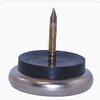I disagree. Packaging was changed to comply with shipping, and proposed future shipping regulation. I have no information about the Federal primers but CCI told me that their primers have remained the same all through the years, but in order to ship them, they needed individualized compartments. Even so, its hazmat. In the "old days", and I go back 45 years or so on reloading, you'd get primers in a smaller tray, each one touching the other in little rows, shoulder to shoulder (in figurative terms). Did anyone ever hear of primers failing in shipping? Not once ever. The Lee manual states that "primers are more sensitive today" and goes on to use the packaging as proof. I think they're connecting dots that need not be connected. Everyone's primer feeds that hold multiple primers has evolved, lawyer'd up. I suppose they are safer, but perhaps a cure waiting for a disease. Reoading well over 10 million rounds over the mid 80's to mid 90's, we never had one accident, and neither was there one prior to my service at that range... going back to the mid 1960's when it opened. Our primers were standard consumer packaging, and we dumped them into a vibratory bowl to get 'em lined up, right way up, and tubed. They got no real special treatment other than the bowl being higher than people. I think the top was about 7 feet from the floor - but I didn't measure it. I couldn't see into it, and I was just shy of 6'2" then... jeeze shrank a half inch in old age!
On one occasion, we had a brazen, opinionated, and very vocal "ex NYC cop" (as he was proud to tell everyone), pull his Glock out of a range bag, after a shooting session - at the cash register (a BIG no-no), take a loaded magazine and insert it (another BIG issue and he was getting warned at that point), drp the slide the pull the trigger, sending a 9mm bullet down the counter, across a small aisle, and into a display of ammo in a shelf against the wall. One round went off in the box of ammo. Mr. "ex NYC cop" got his ass chewed, his membership revoked/refunded and his sorry carcass ejected.
The only accident I've ever heard of with primers was a well known gunsmith decapping live military brass, catching the unfired primers in a large container on the floor under his press. This is an especially dangerous practice, as the decapping pin is pressing on the back of the anvil, and if that by itself doesn't act like a reverse firing pin, then the anvil setback in the cup has made things subject to less movement for an firing to happen. He had the entire large open container of unfired primers go off (aka explode) when one of the cases "went bang" as the decapper hit the anvil in a case, sendind debris down the tube that dropped into the container. It was said he died instantly. To this day I am scared silly about decapping a live primer, and take extra-extra precaution against accidents. For me its usually just one or two cases that were mistakes, but still... one goes off you got little bits flying all around the place, maybe into an eye, an artery... you get the idea.



